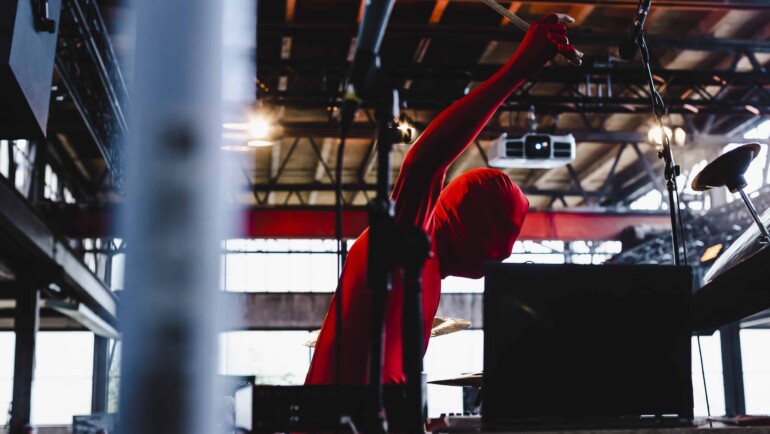
This year’s edition of INTERNATIONAL JAZZFESTIVAL SAALFELDEN took place from August 18 – 21, 2022 with 230 artists from 20 different nations and 65 concerts (39 of which were free) at 12 venues in and around the Alpine town in western Austria. As usual, it was awesome, but this year it was actually amazing. For those of us who have been attending the festival for at least a decade (or others for multiple decades, at that), or for those who jumped on the wagon for the first time this year, there seemed a unanimous assessment among the festival goers: the 42nd edition was banging, and one of the strongest, roundest and most fulfilling in recent times, and possibly in all of the festival’s history. That’s the good news. The bad? How on earth will they top this, next year?







But keeping with the topic of 2022, the festival properly flexed its muscles this year, taking noticeable risks and implementing bold moves. For one, they broke their own record and hosted a total of four(!) big bands on the Main Stage this year (which is essentially, organizational masochism at its finest). But, as the festival team is known to do: they pulled it off, and then some. That being said, “Never again”, says longtime Artistic Director, Mario Steidl, so this one is destined for the history books only. Besides the big band bounty, the booking of acts such as Pussy Riot, The Rite of Trio, Gard Nilssen’s Supersonic Orchestra, the dazzlingly absurd flashmob events, the live-mural-drawing by Artist in Residence, Katharina Ernst, the mountain adventures, the concert on a boat in a lake at sunrise… there was a lot going on, and much of it in unchartered territories.
For years, the festival has been expanding, and in that expansion, dabbling and experimenting – both in concert formats and locations, as well on musical latitudes and landscapes. At this edition, it seemed the fruits, from years of planting the seeds of boundary-pushing and out-of-the-box programming, really came to bear. Jazzfest Saalfelden no longer feels like a “jazz festival” with a few “outliers” sprinkled throughout the program. Rather, the lines begin to dissolve, the bridges reinforced. The organic morphing of tradition and contemporary, of tried-and-true and wildly new, has occurred. The result: a living, breathing festival, full of vitality and tension.




The festival has entered a new era, liberating itself from convention. It has become a gathering of music communities, where “jazz” is an attitude, not a genre. And within that framework, lie endless possibilities of art and mindset, ranging from traditional jazz to free jazz, to pop, to punk or metal, and just about any “genre” or chosen form that aligns with the tenets of the jazz attitude, approach and way of life. Witnessing the tectonic shifts of this 42-year-old festival was a joy. And, as mentioned, it already gets the anticipation engines roaring for next year. (August 17-23, 2023! Mark your calendars!) But for now, what did actually happen this year?
On your marks …
As usual, the festival left the starting blocks bright and early, Thursday morning, with its signature program feature: We Hike Jazz, which, as the name indicates, takes place in the great outdoors, at unusually high altitudes. The master jazz-hiker, himself, having trained across various Austrian mountains for years now, Lukas Kranzelbinder (bass) helped guide the way once again, in extremely good company: with Astrid Wiesinger (sax), Cuong Vu (tr) and Ted Poor (dr). As Mother Nature doesn’t always lay down the red carpet for Saalfelden, these into-the-woods musical undertakings always pose somewhat of a risk to the program. But, luckily, most of the adventurous events could take place this year, including this one. Even luckier – as though staged (which it definitely wasn’t) – as the audience was approaching the concert, they suddenly heard a trumpet beckoning them from above. It wasn’t Vu, as you might expect, but a mere local who was simply taken away by the moment, and made this spontaneous musical mountain call to the International Jazzfestival guests, on the spot. Pure magic.





MELTED
Next up: Melting pot. Did they though? Melt? The answer is a definitive: hell yes – both into each other’s music, as well as our hearts. (Corny, but true.) The Melting Pot experiment – an ongoing European cooperative endeavor between a number of festivals and venues, that brings together a range of artists into a brand new formation, with little to no rehearsal, and certainly no pre-written, or pre-arranged music – puts the power of improvised music on display, and to the test. And at this particular event, the five artists – Hanne de Backer (sax), Zbigniew Chojnacki (accord., electronics), Emil Storløkken Åse (guit.), Beate Wiesinger (bass), Evi Filippou (vibr., perc.) – more than passed.
The combination of the lively percussionist and vibraphone player, working in perfect sync with the saxophonist’s sensitive and versatile approach. The guitarist, out of nowhere bringing in a sweet melody, when just minutes before he was scouring his instrument with a steel dish scrubber with vigorous aggression. The sax player confused us similarly – breaking into tune, suddenly, after nearly an hour of rather continuous noise and abstraction. The accordion player tweaking his instrument and electronic devices, smashing beats that both carried the music while disturbing it, simultaneously. And as usual the bassist spotting the right moments to give space, and the right ones to take it. And when taking it, blowing us away with her depth, groove and strength. Instruments meant to be plucked or strummed, being rubbed and scrubbed. Others meant to be tapped or pounded, being smashed, scraped, redesigned and rerouted. Each musician showing us how genuinely they feel at home in the realm of bold experimentation and unabashed creativity. And with that, they melted our brains completely.
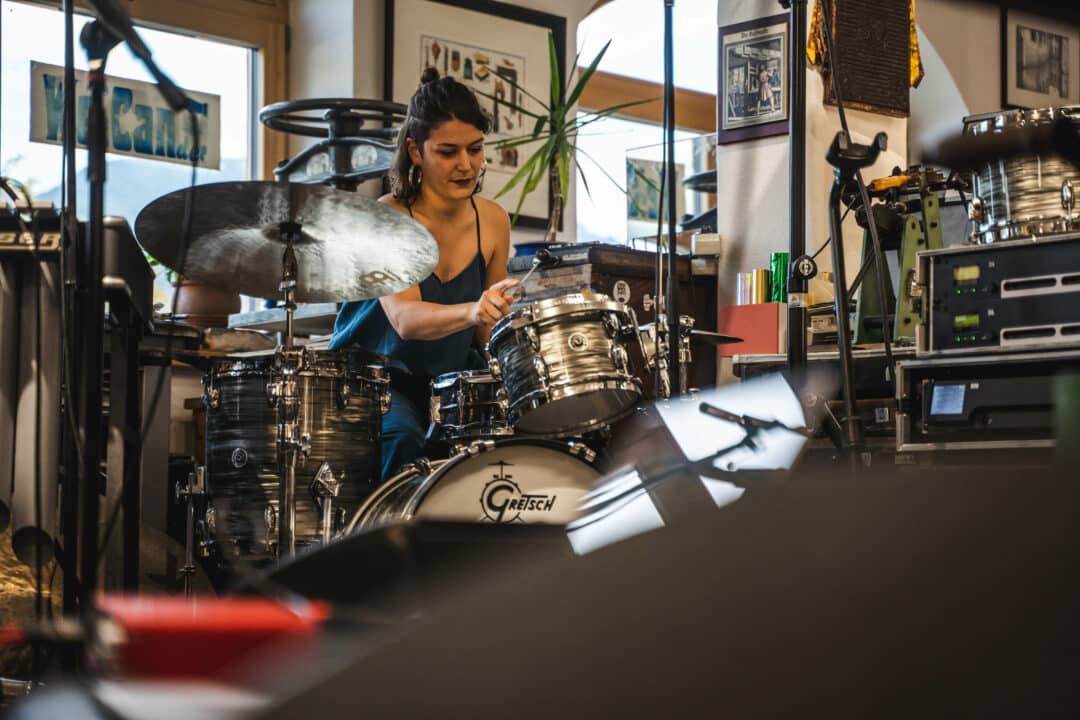

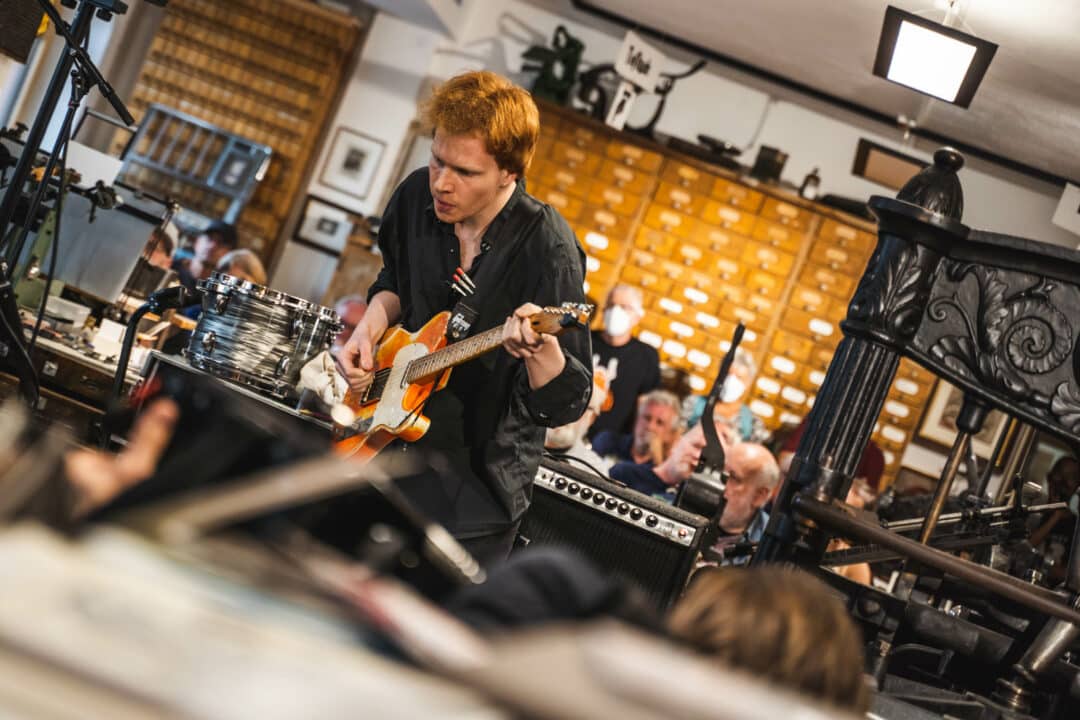


A very noticeable presence at the festival this year was Cansu Tanrikulu. Although she was not actually the third Artist in Residence, you could have fooled a lot of us. She was just about everywhere this year. I wouldn’t have believed she had time to eat or sleep, except for seeing her at the hotel breakfast. Of all of the exceptional work she put out this year, in particular, her improv session with Otis Sandsjö (sax) and Dan Nicholls (keys, synth) at the Fuchs Bookbindery, might have been one of the strongest. Digging deep into her basket of goodies, Tanrikulu shined, brought graceful freedom and sneaky surprises to the musical table they set. Singing in her native tongue (Turkish) at times, Sandsjö would catch her effervescent moments and ride them like an ever-building wave, carrying them to their peak. All the while, Nicholls carrying it through, responding with subtle sonic impulses, like droplets of water dripping throughout, nurturing the ground below them. Next to him, Sandsjö squealing, like a beached whale. Then Tanrikulu howling in shrill “ay ay ay’s” over a peaceful church-like chime by Nicholls. At other times, Tanrikulu breaks into beautiful ballads, while Nicholls takes over the calm bass role on keys – a tranquil thumping of waves gently hitting the shore. Altogether a beautiful, deep-reaching set. Improvization and musical connection at its finest.




AIRBORNE
Ventil is a household name in the experimental music scene. However, their Saalfelden 2022 show was no household event. In fact, it was stupefying, in the best sense of the word. The show began with an almost absurd level of tension with the vocalist’s (Johanna Baader) operatic voice slamming us right in the face with its power and depth, then, further elevated with the unified pounding of the cymbals and the electronics. Then, shifting gears into techno vibes, layered with distorted ever-rising waves of vocals. Tension building again and again, and further, and farther. How long can this last? The edges are being reached and significantly pushed.




All of this excess, carried to yet another level of sensation by Conny Zenk with her mesmerizing visuals, framing the music with architectural, high-contrast, geometrical slow-moving layers. The music, the visuals: Pounding. Penetrating. Abrupt. Keeping us on our toes. Pushing boundaries. Rhythmic aggression. Quiet interludes. Marching band rhythms appear, overlaid by samples of voice and ambiance.


All of a sudden, color appears. Baader reads weather reports. Are we traveling? Seems so. Back to black and white. Foggy amorphous shapes. Then back to the geometric grids, contrasted with the soft purity of Baader’s voice. Have we returned to the urban chaos? Ventil is dynamic, curving and never static (except for the continuous staticky distortions running through nearly the entire performance.)
LAYERED
The band Piled Up is comprised of Cansu Tanrıkulu (comp, voice, efx), Simon Jermyn (guitar, efx), Nick Dunston (double bass, efx), and Lukas König (drums, efx). Like a homage to its own name, the concert itself was a piling up of intricate and distinctive sections. It started off with droney, dreamlike passages including gentle whispers of coughing, whistling and throat-clearing, paired with soft strums on the guitar, and spurts of rattling on the drums and cymbals with sleek metal vibrators (yes, vibrators). Just as absurd and ultimately fitting, harsh sampling of racist right-wing commentary by Andrew Tate enters the soft and gentle scene, with palpable irony. The long stretches of spoken excerpts and electronics continue, until: bam, part 2, when the drummer – known for his power and innovation – steps in and steps up, doing his voodoo magic on a the single cymbal setup that he is known for (KOENIG Solo). Soon thereafter, the jam starts jamming, and it only grows from there. Dunston and König take a moment to unite playing a powerful duo, as if two old friends have entered into deep conversation. And with their infectious energy, the rest of the band has no other choice than to get in on it as well. From that point on, the wave only grew, and it didn’t relent until their time was (sadly) up.





GOING STAG
The mere utterance of the name “Jason Moran” already elicits a reaction in the heart and mind, for any of his fans (and there are many of those). This is an artist who always delivers, but in the most understated, seemingly sincere way. At Saalfelden 2022, he repeated history. Opening up his solo set, he makes a lengthy introduction, intimating how important this festival has been to him in his personal and artistic development, and that he hopes it goes on for a very long time. He then gets right into it – the music. With an utterly relaxed vibe, combined with his rhythmic mastery and musical intricacy, Moran knows how to wow. Yet, at the same time, he has a special knack for boiling it all down – bringing things down to earth, where they came from. Moran exudes a certain intimacy. At moments, it felt like we’ve been invited into his living room, sitting on a couch next to his personal grand, privy to a soirée.


Moran reaches for the mic again and again throughout his set. He has a lot to say. And it’s worth the listen. He talks about his hometown, NYC. One piece is dedicated to his barber. Another, about the legends who originated and came into their own in his neighborhood of Harlem. There is an air of respect and affection, for the music and the people in his world, which permeates his work, which only makes our respect and affection for him and his art, even greater.
You could hear a pin drop during his set – the concentration in the room is intense. Moran – the tightrope walker of smoothness and excitement, gentleness and intensity, agitation and groove. The combination is captivating.

Extrametric is the title of Katharina Ernst’s (2022 Artist in Residence) solo project. Playing drums, drum synthesizer, tamtam, percussion, gongs, amplified kalimba and effects – the artist is very busy, to say the least. Multitasking and whizzing away with polyrhythmic beats, Ernst, quite incredibly, creates a highly intricate kind of dance music, which pounds and pushes. As something she has been working on for nearly five years (likely longer), at this performance, it was clear that she has really found her groove (no pun intended), as the project has grown even fuller, rounder, deeper and richer.



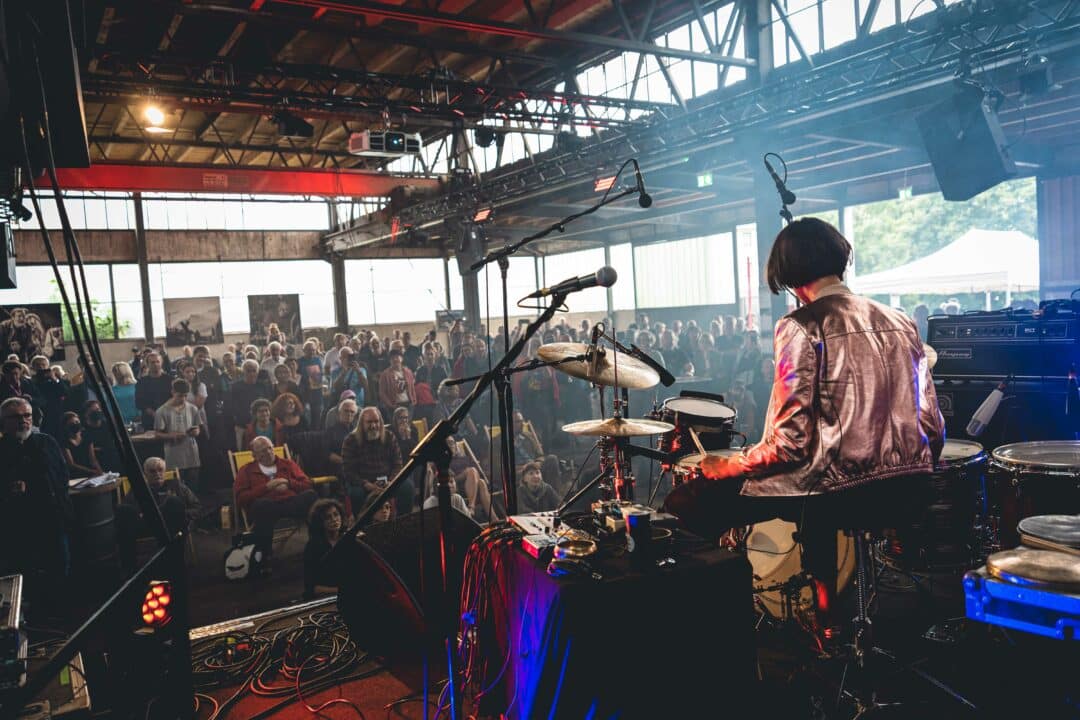
OBSERVING
As every year in recent times, the opening of the Main Stage on Friday evening is more than just a concert. One special individual is given a carte blanche to bring together whatever musicians they choose, and do whatever they please. This year, the honor went to saxophonist, Fabian Rucker, and, to fulfil the task, he brought in Philipp Nykrin (piano, synths), Mike Gamble (guitars) and Kurt Kotheimer (bass, synths) from the U.S., and Austrian NY-based drummer, Peter Kronreif. The concert shifted between full-frontal, in-your-face, rock, free jazz and beautiful, sweetly-landing ballads. This is generally what characterizes the Rucker’s current project, “Observer” – a dynamic, shapeshifting journey, with a big sound, that keeps you on your toes. Moreover, it’s, as well, a very personal journey, as intimated to the audience by Rucker himself, who explained the meanings of each song, with sometimes funny, sometimes touching narrative effects. In one of the stories, he talks about the sheer joy he experienced when asked to take the coveted role of opening the main stage… years ago. But, alas, things didn’t go as planned, and the pandemic forced rearrangements and postponement. That program would have been completely different to that which we experienced in Saalfelden 2022. What we got instead were brand-spanking-new pieces fitting to the times we live in, showcasing the chosen musicians in their most current and freshest forms. In the end, an unforeseen silver-lining to one of the countless pandemic mishaps.
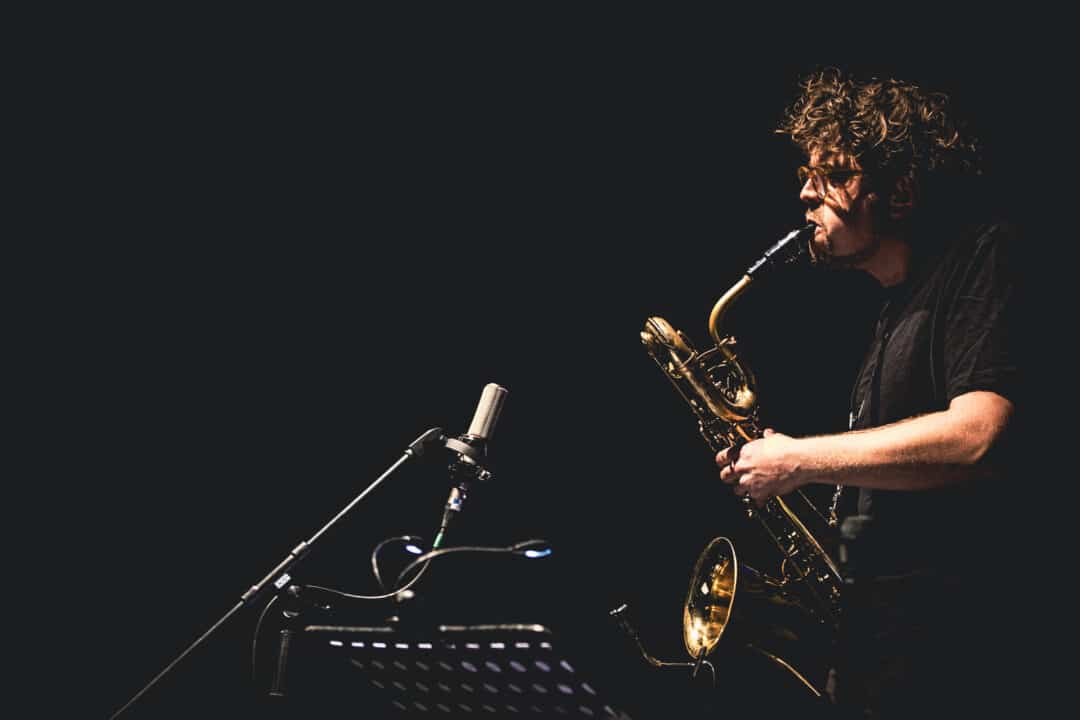
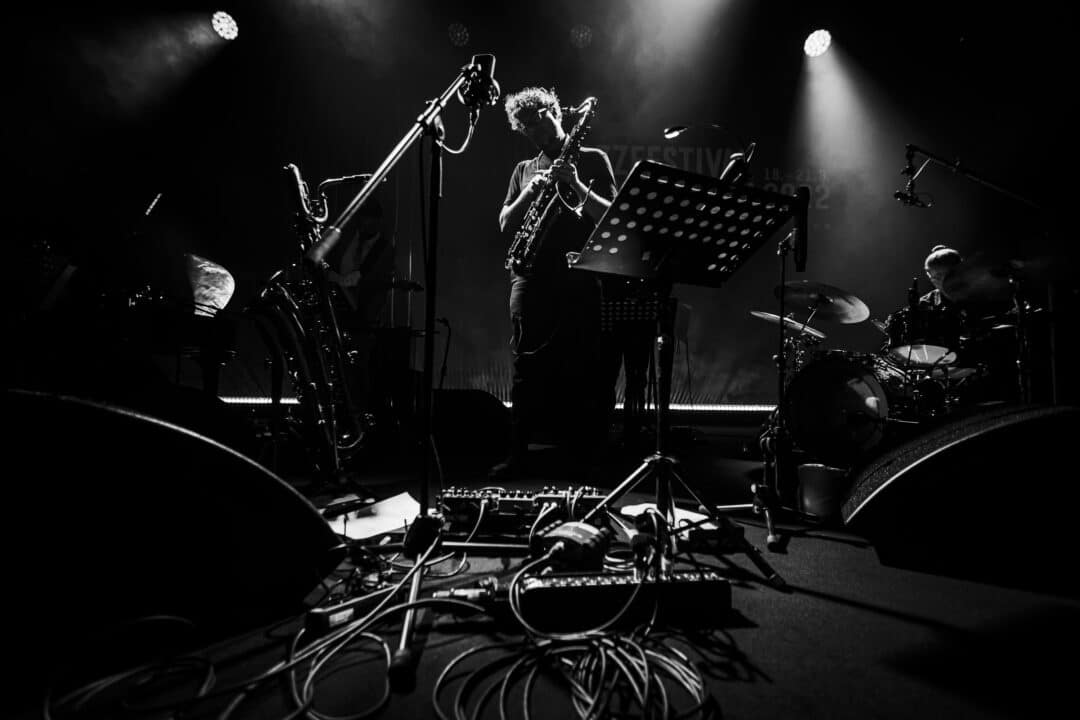


The Berlin-based foursome, made up of Cansu Tanrıkulu (vocals, electronics), Declan Forde (piano), James Banner (bass, electronics) and Max Andrzejewski (drums) carries the name Usine. Interspersed, intersected, distinct, dissected – is what characterized the Usine performance on the opening evening of the festival. Less blending, more fragmentation; the musicians each making space for the other’s sound and approach, respectfully. Distorted grooves, thunderous thuds through megaphones and electronics, drawl-like vocal sounds, scratchy and scrappy, like scraping from the bottom of the pan. A voice which goes so far off, that you don’t know how or if it will find its way back on track again. But then, it does. Panting, sissing, clicking, cooing, hoo-ing, ha-ing. There are ostensibly no boundaries for this band. Unapologetic freedom seems the slogan.




WELCOME
Sharktank (Katrin Paucz, “Mile” and Marco Kleebauer) had never stepped foot onto Saalfelden Jazzfest terrain before – not exactly surprisingly, as they are not exactly a “jazz” band. But as we know that the genre is ever-widening and the musical genre designations, ever-malleable, the distance between the music Sharktank is making and the music which characterizes Saalfelden Jazzfest is, in fact, ever-narrowing. The lines that once existed (though very arguable at that) are getting more and more blurred, and that is to be celebrated. Moreover, audiences seem to, as well, be loosening their belts and consuming a wider, more expansive and more eclectic range of music. All this is to say, although Sharktank was a bit of a wild card in the realm of jazz festivals, it turned out to be a winning one.




The band’s performance on the outdoor stage in the City Park brought with it a completely packed audience, with hundreds of happy concert-goers shaking their hips and bouncing along to the music that most probably didn’t know, but immediately fell in love with. Sharktank is infectious. It has been from the moment it came into being (which is not very long ago at all.) The unique sound of alternative rock, pop, sometime doo-wop-like vocals collaged together with hip-hop beats, rap and electronics, makes for a completely unique sound, delivering musical ideas and messages in a truly unique way. It’s damn good. And the good people of Saalfelden damn well agreed.




ØKSE was a commissioned project by Jazzfestival Saalfelden for Mette Rasmussen (sax) and Savannah Harris (drums), who brought Petter Eldh (bass) and Val Jeanty (SoundChemist) along with them, to make up this foursome of outstanding players. Rasmussen, known in Europe, for her virtuosity and sensitive touch, showed her leadership, together with her partner, Harris, from the U.S., who genuinely wowed us on the drums with her skills, power and drive. This was a bold project, as they explain: The music is fresh. Very fresh. Rasmussen and Harris wrote composed the pieces together in Harris’s NYC apartment just that summer and brought it to the festival, where they only had the chance to rehearse it the day before and day of the concert. Well, they could have fooled us. The performance was seamless and entirely satiating.




NEVER A DULL MOMENT
Petter Eldh (acoustic bass), André Roligheten (acoustic saxophones) and Gard Nilssen (acoustic drums) make up the trio, Acoustic Unity. On Saturday afternoon, their music graced the stage of Kunsthaus Nexus, and showed what ‘unity’ really looks like. The three musicians communicated in such notable harmony with one another, that it wasn’t a surprise when Artist in Residence, Gard Nilssen announced that he is playing with two of his best friends here. Some noteworthy moments were: an incredible bass solo, as though the player was scraping from the depths of his soul, while the bandmates looked on with deep appreciation. It seemed to have inspired them, as when they jumped back in the game, playing as three, they did so with even greater vitality.

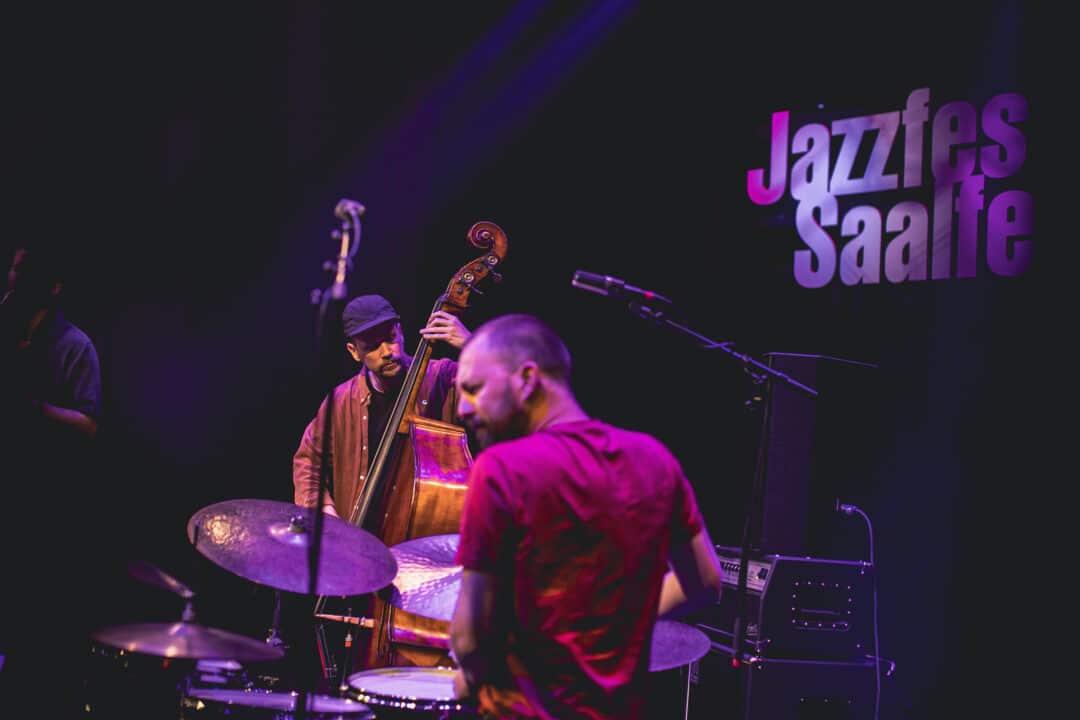
Never a dull moment at this show. Spaces of quiet serenity were followed by passages of wild joy and energy, though always surreally in sync. Nilssen provides twinkling taps and rattles to the palette, dancing together with the sax’s air-infused poofs, while the bass grabs the tail of the drums, tying it all together. Experiencing Acoustic Unity is like riding a train, on which some passages, you glide past flat fields at slow speeds, then at others, you speed up, racing past vibrant scenes of cities, mountains, forests. Like life itself, never stagnant.
While listening to Émile Parisien’s (sopr sax) sextet “Louise” with Theo Croker (tr), Manu Codjia (guit), Roberto Negro (pi), Joe Martin (ba) and Nasheet Waits (dr), the word that kept coming to mind was, “Damnnnn”. Not exactly surprising, given the lineup. The band could be described as lazy jazz, rocking out, laid-back slamming, with moments of melancholic joy that you just wanna lie down in. All the blissful oxymorons. There were portions of calm and, of course, moments of insanity. A particular stand-out was when Martin and Waits broke out into a mind-breaking duo which stole the already stolen show.





Bushman’s Revenge is one of the signature projects of Gard Nilssen, one of the two Artists in Residence at the festival this year. The band – Even Helte Hermansen (guit), Rune Nergaard (bass), Gard Nilssen (drums) – has been playing together for around 20 years, and the effect is: strength and joy. The freedom the trio embraces, going headfirst into rock, while carrying, at its base, the tenets of free jazz, makes for a wild and exhilarating listening and watching experience. The double decades have done them well.



BIG
This year was the year of the big bands. And Christoph Cech’s Jazz Orchestra Project counts as one of them. The ensemble is comprised of Christoph Cech (piano, all compositions, leader), Thessa Habeler (vocals, violin), Simon Frick (violin, e-violin), Jelena Popržan (quinton viola, vocals), Katharina Baschinger (diatonic harmonica), Valentina Cinquini (concert harp, Markus Pechmann), Johann Öttl (trumpets, flugelhorns), Alois Eberl, Daniel Holzleitner (trombones), Florian Fennes, Ilse Riedler, Fabian Rucker, Philipp Wohofsky (keys), Andi Erd (guitar), Philipp Kienberger (bass), and Andi Senn (drums). By just reading the names, it is obvious that this band is not only big, but very talented, hand-picked by the bandleader and Austrian legend. Beautiful cinematic-like compositions, breaking into hard rock pieces, a personal taste that Cech is famously known for. This band could really groove in unified brilliance, boasting an especially strong horns section, and guided, as well as expanded by the leadership of the maestro himself on piano, Christoph Cech.







Trondheim Jazzorchestra & Jason Moran was another one of the four big bands to play Saalfelden 2022 (as mentioned, a record they will never again try to match, we’re told). The concert started off with Moran’s iconic Ringing My Phone (Straight Outta Istanbul) piece, filled out with the potency of the all-star big band. Alto sax soloist Mette Rasmussen made her mark almost immediately, with her solo on the second tune. Structurally noteworthy was the stage setup: the drums in the middle of the stage and band, front and center, thereby changing the entire perception and flow, for both the musicians and audience alike.


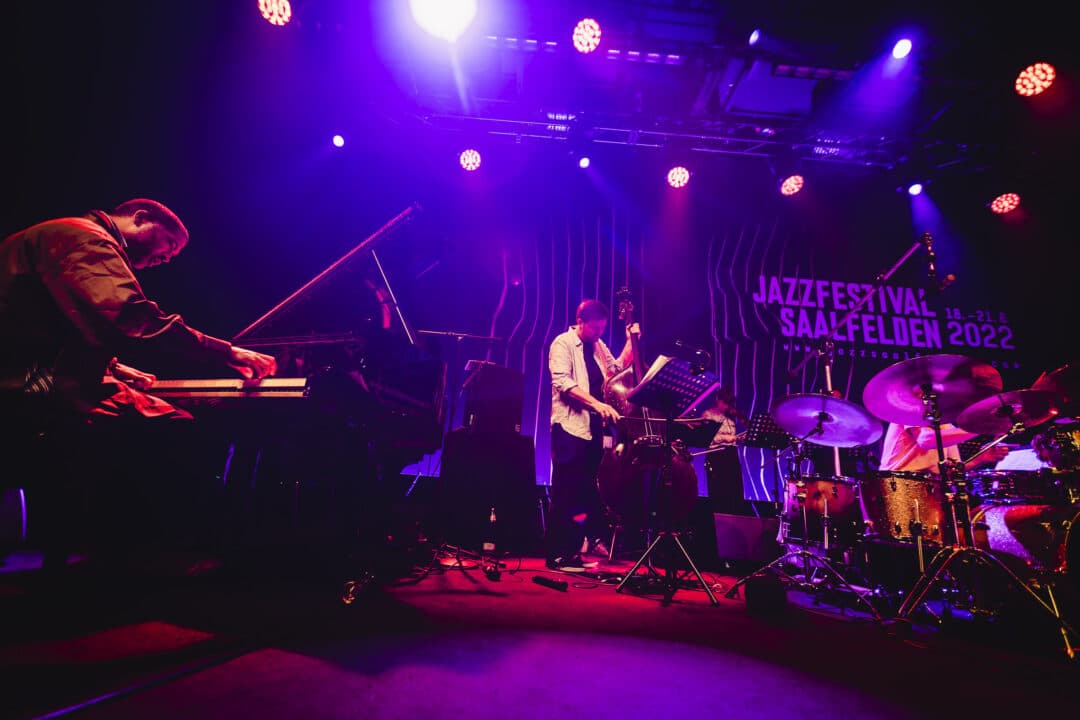




Speaking of structure, Gard Nilssen’s Supersonic Orchestra was not only a sight to be seen – with three drum sets, three double basses, eight saxes, a trumpet and a trombone – but, as well, a sound to be heard. How to play free jazz in such a large setting and not have it collapse into total chaos? No idea. But that is indeed what happened. Like running a rally, the musicians passed the baton between one another. Duos here. Trios there. Then free-for-all moments where the whole lot joined forces. Out of nowhere, a passage of clapping by the majority of the musicians, bringing the intensity and the volume down for a moment – a smart strategy. The calm before the storm, building anticipation for the moment of release when they will all come back with their instruments roaring; which, of course, they did.


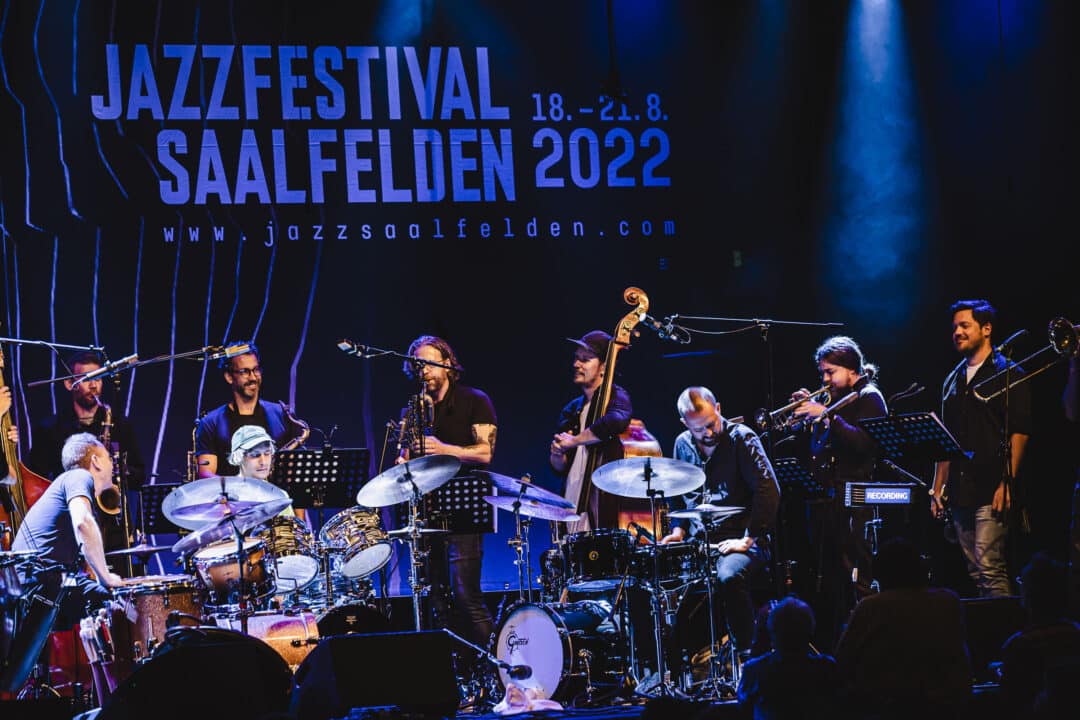



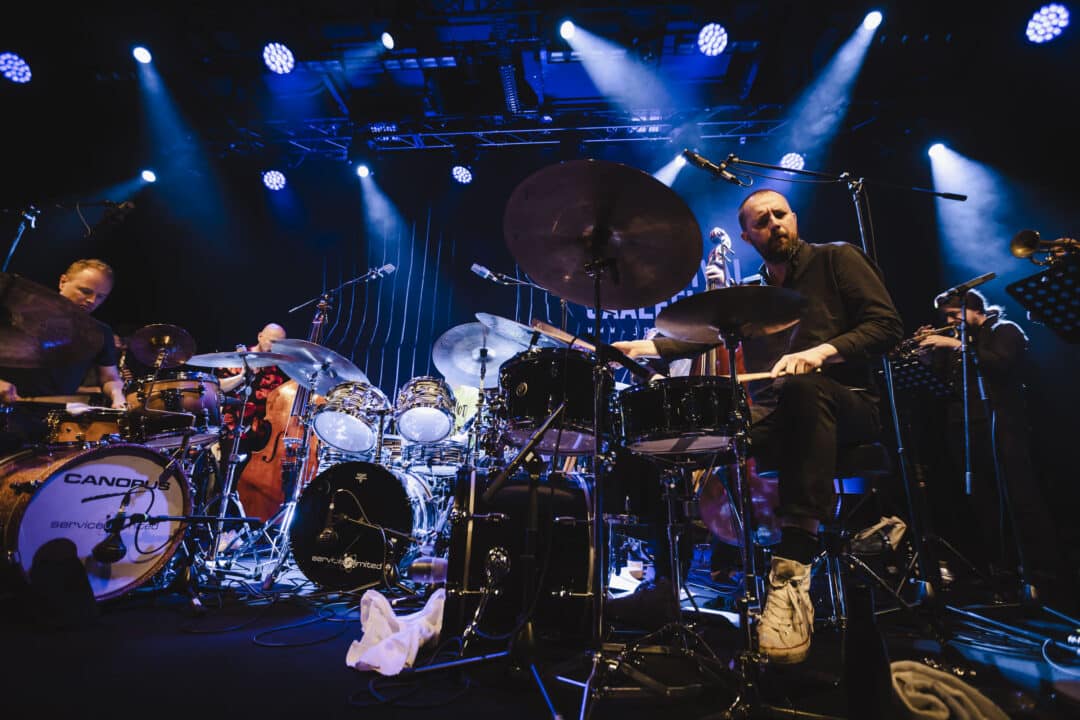
Just, LIKE, WHOA
If there was a Saalfelden 2022 show-stealer, it was quite arguably Pussy Riot. It’s hard to put into words how powerful this performance was; but it was, indeed, extraordinary. The combination of stark political messages, proactive feminist advocacy, and storytelling of purgatory, imprisonment, abuse and escape, with the sheer intensity of the performance – punk, rock, rap, call and response, electronic beats and acoustic drums, combined with videos, running text and storyline, dance and theatrical elements – made it a true Gesamtkunstwerk, so to speak. The audience was blown away, shocked and in awe, touched and moved, inspired and enraged, and all the while banging heads and dancing along. It was: everything.




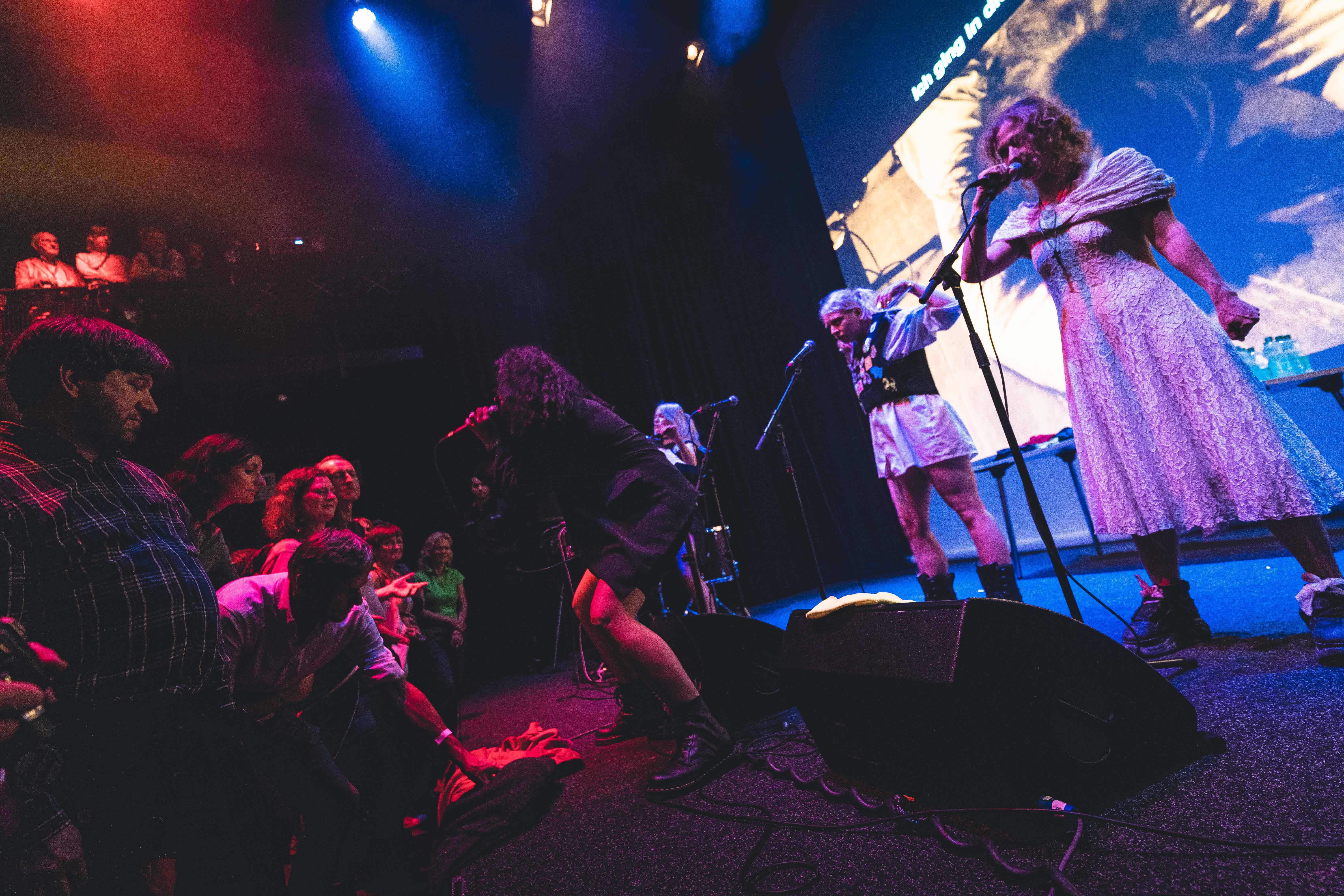
As Pussy Riot explains: “The show is a theatrical adaptation of Riot Days, the book in which Alyokhina denounced the mistreatment of women in Russian prisons. She said that feminism is making inroads all over the world except in Russia. ‘Russia is dystopian. It doesn’t even have a law against male violence. If I punch you in the street, I’m sure I’ll end up in jail. But if your husband hits you at home, he will be fined €50 and that’s it. And if you are raped, it will be your fault for dressing the way you did. Feminism, even as a word, is an enemy of the state in Russia. It is associated with the West, and with Evil,’ she said.” At this performance was: Maria ‘Masha’ Aljokhina: author, actress, Diana KOT Burkot: singer, actress, electronics, drums, Olga Borissova: singer, actress, editor, Anton Ponomarev: saxophone, Wassili Bogatow: video




If you haven’t seen Y-Otis live yet, I’m sorry for you. Your life is not yet complete. Ignorance is bliss, but now that you know about it, the bliss is over. Sorry.
Only half-kidding here, the Y-Otis show to cap off Friday night was: lit. It took place in the middle of the cozy (as in, not very spacious) bar at Nexus. At first glance, the choice of location was a little confusing – why not in the empty concert venue in the same building? But quickly, it became obvious: To experience Y-Otis, is to be part of Y-Otis, in the best case that is. It’s about community, and letting yourself melt into the show, until the music is you and you are the music. More than that, it’s just incredibly fun, standing more or less shoulder-to-shoulder with one of the four players, bopping along. And this is nothing to speak of the music, which is a melange of hip hop, shapeshifting melodies, irregular rhythms and velocities, sonic experiments, beat-heavy, joy-infused very good music. Y-Otis is saxophonist, Otis Sandsjö‘s proud creation, for whom he brought keyboardist Dan Nicholls, bassist Petter Eldh and drummer Tilo Weber to join the ride.



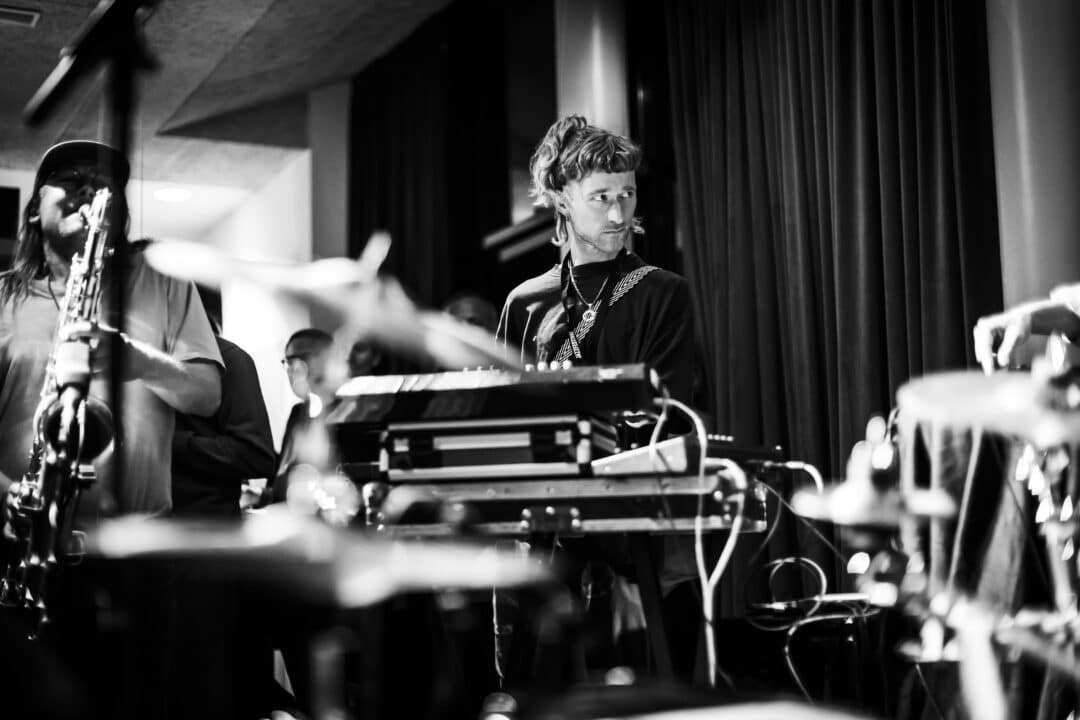

OUT THERE
For the Mountain Tracks portion of the festival, a natural pop-up scenario is set, where audience members are invited to partake in a concert in one of the countless idyllic spaces in the great outdoors, just outside of town. On Sunday morning, the final day of the festival, another improvisation session occurred, this time with Cuong Vu (trumpet), Even Helte Hermansen (guitar) and Gard Nilssen (drums). Walking the hiking trail to the concert through the woods, you could hear the sounds of the instruments well before you could see them. Once you finally got there, an even more unbelievable picture emerged. About a hundred (or more) people sprinkled throughout the wooded area, sitting on moss patches, perched on rocks, leaning on trees, standing in bushy blotches, all facing one direction – like an assembly of the Elves in the “Lord of the Rings” – only in this case, the master of ceremonies was the music. The trumpet screamed into the forest like a bird call; the drums pitter-pattered against the soft but solid bark; the guitar swirling through the leaves, the grasses, the branches; and the sun streaming through the trees danced along. Nature and music intertwined: pure serenity.
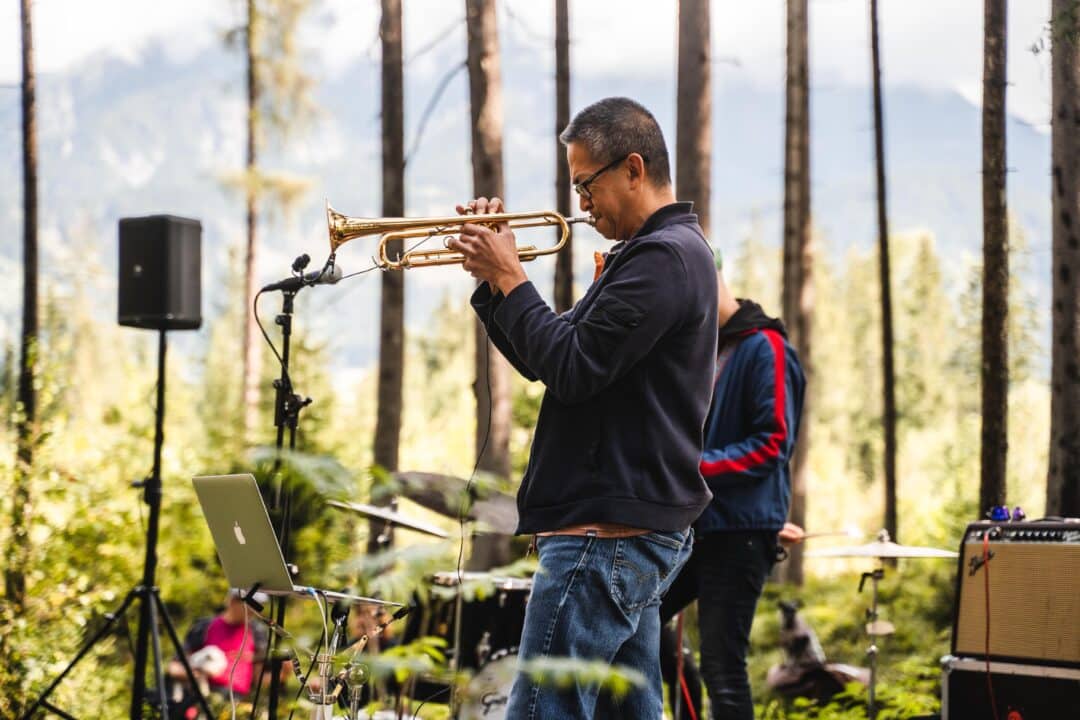




Inspired by Stravinsky’s most famous piece, The Rite of Spring, André Silva (guitar, voice), Filipe Louro (bass, acoustic guitar, voice) and Pedro Alves (drums, electronics) from Portugal collectively call themselves: The Rite of Trio. As an introduction to their show, the moderator intimated to us that after the Pussy Riot performance the night before, this band humbly asked themselves, why they make music and to what purpose. (A question many were probably asking after such a momentous event.) But, with their show at the Otto-Gruber-Hall on Sunday, they certainly answered it. Walking the edge of fine compositions with metal attitudes and melodic slants, the trio knows how to maintain a provocative amount of tension, and then, dance with it. At one memorable moment, the whole band began laughing and screaming within the music, as though mentally mad, but full of joy. This trio, dressed in theatrical red costumes, fully masked, and partially naked, certainly made their mark, both visually and sonically.


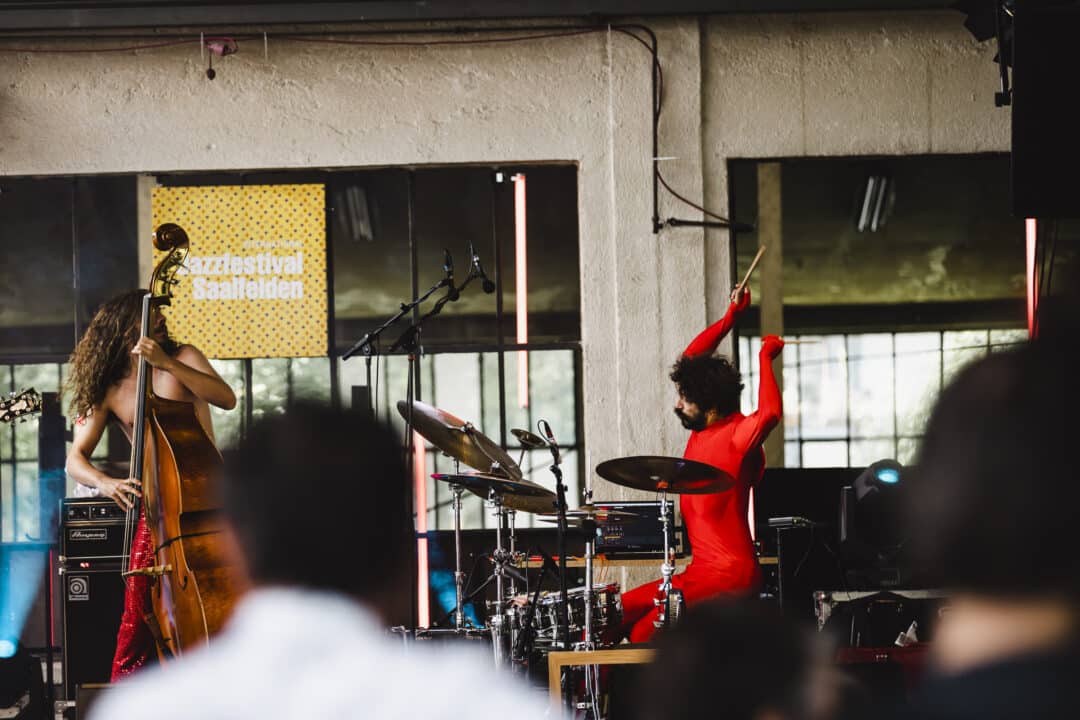

On the fly
One of the last Improv Sessions of the festival took place at the upstairs level of an old tavern, the Brücklwirtshaus. The building dating back centuries, and the interior design and deco looking just about as historical and traditional, it created a beautifully interesting contrast to the music to come – a highly free, loud and extroverted improv set among young, contemporary Berlin-based musicians. Although it was very unfortunate that Sofia Jernberg (voice) – the host of the session – couldn’t make it in the last-minute, therefore necessitating a spontaneous switch of characters, a silver lining did appear. Subbing for Jernberg on voice, was Jim Black on drums – clearly a completely changed setup and sound. But, not a lesser one. What transpired was the display of three superb Berlin-based musicians – Cansu Tanrikulu (comp, voice, efx) Nick Dunston (bass), Jim Black (drums) – connecting, captivating and really jamming. The level of trust, respect and ease among the musicians was palpable, and seeped strongly into the music. This firm grounding provided a base to stand on, and to leap of off; for their inherent wildness, power and creativity to soar.





Jazzfest Saalfelden dates have already been announced for next year: August 17-20, 2023. See you there!
Arianna Alfreds
